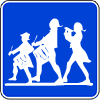When the National Road was extended west from Wheeling, the mandate was to build a road directly from one state capitol to the next. In doing so, many existing communities found themselves not necessarily on the path of the National Road. Some cities such as Dayton, Ohio, were really upset at the political and highway engineering slight. It was clearly a case of not being in the right place. Prior to the road's arrival in western Ohio, Dayton's political leaders fought hard to introduce a slight bend in the road that it would pass through Dayton. East of Columbus the city of Newark had been missed and Dayton was bound and determined to not let that happen to them.
Alas, all of their efforts were in vain when President Andrew Jackson overruled the recommendations of the Ohio Legislature and ordered that the road be built straight and without detour. The net result was that like Newark, Dayton was bypassed by about 10 miles. Undeterred, the city's leaders came up with an ingenious solution, albeit somewhat unethical.
The city quickly built their own road from Springfield to Dayton, thence to Eaton and up to Richmond, Indiana, where it rejoined the National Road. While the Dayton Cutoff was a more logical route to follow (adding just four miles), the city of Dayton realized it had a marketing problem. Dayton's spin doctors went to work and the deception began.
First, Dayton erected milestones along its road that were nearly exact copies of the milestones found along the National Road. Second, at he fork in the road, the cutoff's proponents had a sign erected telling emigrants that the fork to the left was the National Road, when it fact it wasn't.
All of this deceit really wasn't necessary as word got out that the Dayton route was the better choice. In the end, the Dayton Cutoff enjoyed great success since it was the superior road. The Dayton Cutoff offered a better road surface, two large communities (the northern option only had tiny villages), and merchants with whom emigrants and travelers could do business. The Dayton Cut-Off was also the route used for the National Old Trails Highway.
The trend to take the loop south to Dayton continued many years later. Up until the 1960's when I-70 was built to the north, commerdcial traffic (trucks, buses, etc.) would follow the path of the old cutoff.
View user comments below.































